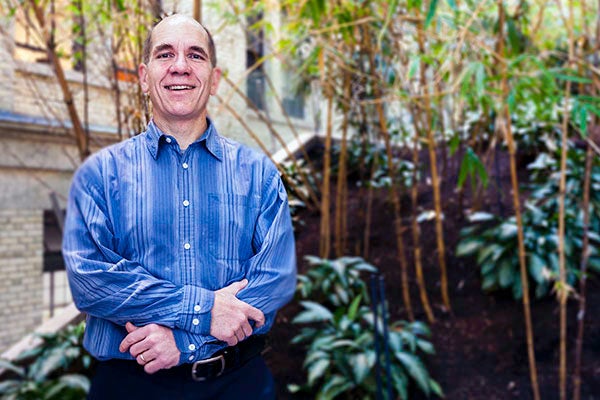
Danny Harvey on climate change: "we have to get going right now as hard and fast as we can"
Published: December 2, 2014
Climate change is dominating news headlines – from the recent agreement by the U.S. and China to curb greenhouse gas emissions to the United Nations Climate Change Conference (COP 20) taking place now in Lima, Peru.
Professor Danny Harvey is one of the researchers seeking solutions to climate change. In addition to teaching classes in global warming and energy efficiency in U of T’s geography department, he’s also contributed to the United Nations Intergovernmental Panel on Climate Change report.
Writer Dominic Ali explores cities and urban issues for U of T News. He spoke with Harvey about climate change and how better-designed buildings and cities can be part of the solution.
How did you first become interested in researching climate change and energy efficiency?
I first heard about the prospect of global warming due to human emissions of greenhouse gases in 1978, as an incoming graduate student here at U of T taking a course from geography Professor Ken Hare. I looked into the science of global warming as of the mid- to late-1970s and concluded that this was a real problem that was not going to go away. After working on climate modelling related to global warming for 20 years, and with the science only getting stronger, I started making a transition toward researching solutions, and that is pretty much all that I work on now (while keeping up on at least the key climate science).
How do Canadian cities rank in terms of energy efficiency? Are we a model of sustainability for other countries?
Canada as a whole is not a model of sustainability or anything close to it. We have close to the highest per capita energy consumption and CO2 emissions in the world, and we cannot blame that on our climate or large expanse. We are building glass boxes in a cold climate, and much of our urban development is sprawling and built for the car.
How might more sustainable buildings improve urban areas?
Depends on what you mean by sustainable. For me, sustainable in the energy dimension means that the energy use is small enough that, if our entire building stock was retrofitted down to that level, we could supply the resulting total energy demand entirely from renewable energy sources (not necessarily entirely from within a city itself or even nearby). That would certainly relieve energy transmission bottlenecks. Concerning urban design, cities that facilitate walking and cycling are generally rated as being much more pleasant and vibrant cities than those built for the car.
What are some ways individuals can reduce their climate impact?
Shift to a low-meat, vegetarian or near-vegan diet is probably the single largest thing that we could do (and it would be good for our health, too if the right foods are substituted for animal products). Also of great importance would be insulating our residences and sealing up leaks in old houses (leaks can account for 30-40 per cent of the total heat loss in winter), and switching to a high efficiency space and water heating and to high-efficiency appliances when they need replacement. And of course, driving as little as possible, making everything we buy last as long as possible and using energy as sparingly as possible.
What are some practical strategies municipalities can implement to fight climate change?
They can do everything within their power to promote alternatives to the car for transportation (including promoting mixed land use and higher urban density, as well as improving public transit and facilitating walking and bicycling). Equally important, they can provide incentives for developers to go beyond the existing provincial or national building codes in terms of energy use.
A number of cities in Germany and Austria adopted requirements in the 2000s that all publicly-funded buildings meet the Passive Standard for heating. This standard is equivalent to permitting about one-tenth the average heating requirement of residential buildings in Canada. As of next January, all new buildings in Brussels will have to meet the Passive House standard.
Toronto has its Green Energy Standard, but it requires only a 10-15 per cent reduction in energy use compared to the current Ontario Building Code. But this is only a voluntary standard.
What’s the biggest challenge facing cities like Toronto when it comes to dealing with climate change?
I think that the challenge for everyone is that it is too abstract and not immediate in its full impact. It will take until the end of this century to fully make the transition off of fossil fuels that is necessary if we are to have a chance of limiting global mean warming to 2 C above pre-industrial (the internationally agreed target), and that seems like so long that it is easy to delay. But if one runs scenarios – which is what I do these days – one sees that we have to get going right now as hard and fast as we can, especially for buildings, which last over 100 years and are hard and difficult to fix once they're built.



